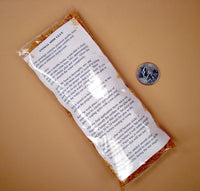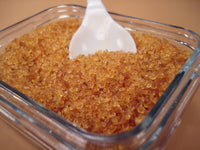Animal Hide Glue - 5 oz -
Granular natural animal hide glue for primitive craft projects. Can be used for anything from attaching feather fletching on arrows, gluing sinew onto the back of a bow, attaching and hafting points on arrows and cementing blades into knife handles. The original natural glue. Priced per 5 oz bag.
Premium granular animal hide glue perfect for arrow, spear and knife attachment, hafting and for sinew-backed bows.
Diluted hide glue can also be used to carry and stabilize natural pigment powders for natural paints.
5 oz poly bag with instructions for glue preparation.
Using Natural Animal Hide Glue for primitive weaponry projects:
Use a premium quality hide glue formulated to be water soluble and usable at different thicknesses.
To mix:
Prepare a double boiler or pan that is clean and can take some heat. Mix approximately 50% by volume glue and water. Allow the glue to absorb the water completely. Apply the heat to thoroughly mix and liquefy. Add more water as needed to bring the glue to the proper consistency. Most people try to use glue that is too thick. If you add too much water, either add more glue or cook the extra water out of the mix. Do not scorch or boil the glue mix, as this can hurt the properties of the glue and cause objectionable odors.
To use:
Keep the work piece clean and free of excess glue by careful application and quickly wiping spills with a wet cloth. Moisten hafting, wrapping, sinew or rawhide first with water then with the glue mix and squeeze out any excess before wrapping the item. Hide glue is liquid when hot or very warm and will gel or thicken if allowed to become cold. Do not hesitate to add more water or change the temperature of the glue to make it more usable. After the final application layer, use a warm, wet finger to smooth the surface of the glue and even out lumps or thin spots. A toothbrush wet with warm water will allow you to clean your work piece. If you are wanting an antique look, throw some dry dust onto the moist surface of the hide glue as it dries. Set piece aside and allow 1 to 24 hours for glue to dry completely before waxing or using. Natural hide glue will become sticky if exposed to excessive moisture, but must be soaked for hours before it will soften enough to lose its grip. Paste wax is recommended for all applications what will see use. To antique use a dirty or pigmented paste wax. Hide glue can be sanded smooth after drying, but pains should be taken to do the best job possible during the wet stages. Natural hide glue is compatible with natural sinews, gut hafting material, rawhide and leather. It will adhere to these materials and make a very strong, fiber reinforced bond. It is not compatible with waxed artificial sinew, nylon or other plastic or water resistant materials. To make your hide glue look less refined you can add ochre pigments or a little dry dust. A touch of dull yellow and a touch of black iron oxide will make a nice brownish green that matches burned wood, the patina on some stones and patinaed bone handle materials.
Making Molds using Hide Glue
If you make your hide glue especially thin, and cool it, it will congeal into a gelatin like jello but a bit stronger. You may have to experiment with the exact mix, but this was used to make molds for plaster work for a very long time. Make a box that will contain your model. Best is to make the box with screws so it can be partially disassembled during casting. Affix your model to the bottom of the box using hot glue or something NOT water soluble. The attachment should be on the back or somewhere that will eventually become the opening through which the Plaster of Paris is poured. Spray the entire inside of the box with Pam or use Vaseline applied with a brush to keep the glue from sticking to the model or the box. Mix the hide glue hot and pour it around the original and fill the box with glue. Tamp and tap the box to release air bubbles. Allow to cool until congealed. Remove one or more sides of your box and carefully remove the mold original. The mold will start to dry out so use it quickly. Replace the cooled gelatin mold into the box for firmness and pour in mixed plaster. Immediately fill the mold with mixed plaster. Agitate and settle to remove air bubbles from the plaster. Allow to harden for 25 minutes. Remove and recast as desired for multiple copies. You can re-use your glue if you do not allow it to dry out too much or become contaminated with debris. Wet rubber can be frozen to keep it from spoiling, but molds do not keep well and you may have to re-pour your mold.






